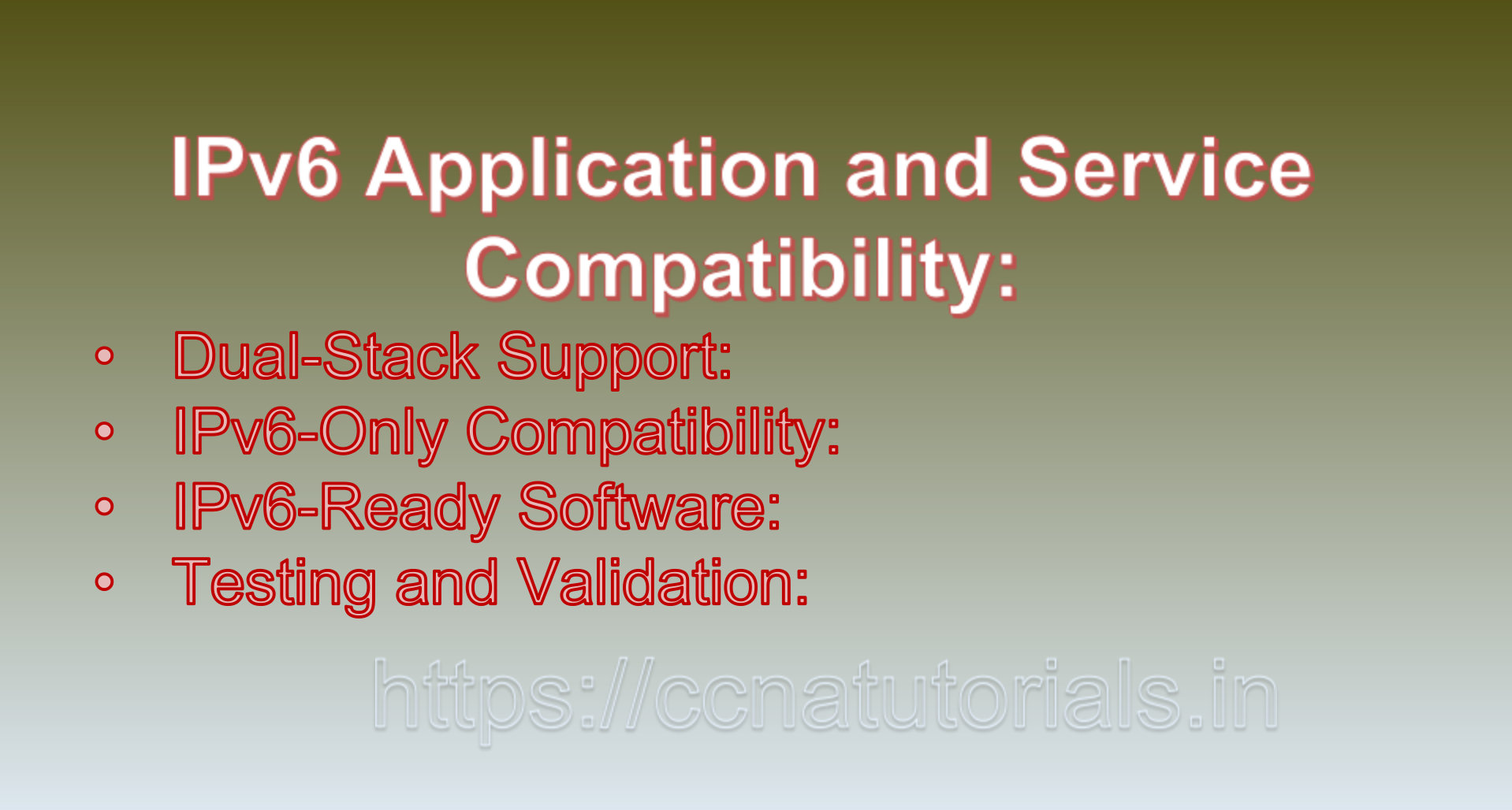Contents of this article
In this article, I describe IPv6 Application and Service Compatibility: Enabling Seamless Transition. IPv6 application and service compatibility is a critical consideration as organizations transition from IPv4 to IPv6. Ensuring that existing applications and services function seamlessly in an IPv6 environment is essential to maintaining business continuity and user satisfaction. This article provides an overview of the challenges and strategies associated with IPv6 application and service compatibility, accompanied by real-world examples to illustrate their significance.
Challenges of IPv6 Application and Service Compatibility:
1. Address Format:
IPv6 addresses are represented in a different format than IPv4 addresses. Applications and services that rely on IP address parsing, storage, and manipulation need to be updated to support the longer IPv6 addresses.
2. Socket Programming:
Applications that use socket programming need to be adapted to work with both IPv4 and IPv6 addresses. This includes changes to functions like `getaddrinfo()` and `bind()`.
3. DNS Resolution:
DNS resolution is a critical component of application communication. Applications must be able to resolve both IPv4 and IPv6 addresses from domain names.
4. Firewalls and NAT:
IPv6’s different structure may require adjustments to firewall rules and Network Address Translation (NAT) configurations to accommodate both address formats.
5. Legacy Applications:
Many legacy applications and systems were designed exclusively for IPv4 and might not have native IPv6 support.
Strategies for IPv6 Application and Service Compatibility:
1. Dual-Stack Support:
Implementing dual-stack support involves enabling applications and services to work seamlessly with both IPv4 and IPv6. This approach allows for a gradual transition while maintaining compatibility.
2. IPv6-Only Compatibility:
Adapting applications and services to work exclusively in an IPv6 environment might involve significant changes but can simplify the network architecture and avoid dual-stack complexities.
3. IPv6-Ready Software:
When selecting or developing software, prioritize options that are designed to be IPv6-ready, reducing the need for extensive modifications.
4. Testing and Validation:
Rigorous testing is crucial to ensure that applications and services function correctly in IPv6 environments. Comprehensive testing helps identify and address compatibility issues.
IPv6 Application and Service Compatibility Example:
Consider an organization that offers a web-based application accessible through a domain name. The application uses DNS resolution, socket programming, and data exchange between clients and servers.
1. DNS Resolution:
– Challenge: The application’s DNS resolution process needs to work seamlessly with both IPv4 and IPv6 addresses to ensure clients can access the application regardless of their network protocol.
– Solution: The application should use functions like `getaddrinfo()` to obtain both IPv4 and IPv6 addresses from the domain name.
2. Socket Programming:
– Challenge: The application’s socket programming code must be compatible with both IPv4 and IPv6 addresses.
– Solution: Use libraries that support both address formats, and adapt functions like `bind()` to work with IPv6 addresses.
3. Data Exchange:
– Challenge: The application exchanges data between clients and servers. Compatibility is required for data transmission using IPv6 addresses.
– Solution: Ensure that the data exchange components are adapted to handle IPv6 addresses and packets.
4. Testing and Validation:
– Challenge: Ensuring that the application works flawlessly in an IPv6 environment requires thorough testing and validation.
– Solution: Set up testing environments that mimic real-world scenarios, including both IPv4 and IPv6 networks. Validate the application’s functionality, performance, and security in both environments.
Importance of IPv6 Application and Service Compatibility:
1. Business Continuity:
Ensuring that applications and services are compatible with IPv6 guarantees uninterrupted operations during the transition from IPv4 to IPv6.
2. User Experience:
Compatibility issues can disrupt user experience and result in downtime. Seamless compatibility ensures that users can access services without interruption.
3. Efficient Transition:
Smooth application and service compatibility streamline the transition process and prevent delays caused by technical challenges.
4. Future-Proofing:
Investing in IPv6 compatibility prepares organizations for the future as IPv6 adoption continues to expand.
In short IPv6 Application and Service Compatibility:
IPv6 application and service compatibility is a crucial aspect of a successful IPv6 transition. Ensuring that existing applications and services can function seamlessly in IPv6 environments requires adapting code, validating compatibility, and potentially making significant changes to ensure dual-stack support. Real-world examples illustrate the challenges and solutions in maintaining smooth application operation during the transition. By adopting strategies like dual-stack support and thorough testing, organizations can navigate the complexities of IPv6 compatibility and provide uninterrupted services to users in both IPv4 and IPv6 networks.

IPv6 Application and Service Compatibility: Ensuring Seamless Transition
IPv6 application and service compatibility is a crucial aspect of the transition from IPv4 to IPv6, as it ensures that existing and new applications can function effectively in IPv6-enabled environments. As organizations adopt IPv6 to accommodate the growing number of Internet-connected devices, it’s essential to assess the compatibility of applications and services to maintain uninterrupted communication. This article provides an overview of IPv6 application and service compatibility, its significance, and real-world examples to illustrate its importance.
IPv6 Application and IPv6 compatibility refers to the ability of applications and services to operate seamlessly in IPv6 networks without encountering functionality, performance, or security issues. As organizations transition to IPv6, they must ensure that their applications, software, and services are adapted or developed to work effectively with IPv6 addressing and networking mechanisms.
Key Aspects of IPv6 Application and Service Compatibility:
1. Addressing Format:
IPv6 uses a different addressing format compared to IPv4. Applications and services need to support the longer IPv6 addresses and accommodate the use of colons in the address representation.
2. Socket API Support:
Many applications use the socket API to establish network connections. IPv6 compatibility requires applications to use the appropriate socket functions for IPv6, such as `AF_INET6` and `SOCK_STREAM`.
3. DNS Resolution:
Applications often rely on DNS to resolve domain names to IP addresses. IPv6 compatibility includes ensuring that applications can handle AAAA records and perform DNS lookups for IPv6 addresses.
4. Network Protocols:
IPv6 introduces new networking protocols and headers. Applications need to be aware of these changes to ensure correct interpretation and processing of IPv6 packets.
5. Security Considerations:
IPv6 introduces security features such as IPsec integration. Applications should be designed to take advantage of these features while maintaining compatibility with IPv4 environments.
IPv6 Application and Service Compatibility Example:
Consider a scenario where an organization has a web-based application that allows users to log in and access their accounts. As the organization transitions to IPv6, it must ensure that the application remains compatible:
1. Address Handling:
The application must be updated to handle IPv6 addresses when processing user input or logging user activity. It should also accommodate the longer IPv6 addresses in user profiles and logs.
2. Socket API:
The application’s network code needs to be modified to use the appropriate socket functions for IPv6, allowing users to connect to the application using both IPv4 and IPv6 addresses.
3. DNS Resolution:
The application should be capable of resolving both A (IPv4) and AAAA (IPv6) records during DNS lookups. This ensures that users can access the application regardless of the IP version they are using.
4. Network Protocols:
The application’s network protocols and headers need to be adjusted to correctly handle IPv6 packets. This includes proper interpretation of IPv6 headers and addressing.
5. Security Integration:
If the organization leverages IPsec for security, the application should be configured to use IPsec for both IPv4 and IPv6 connections, ensuring data confidentiality and integrity.
Importance of IPv6 Application and Service Compatibility:
1. Continuous Operations:
Ensuring compatibility enables organizations to maintain operations and provide uninterrupted services during the transition to IPv6.
2. User Experience:
Applications and services that are IPv6 compatible ensure a seamless experience for users, regardless of whether they are accessing resources using IPv4 or IPv6.
3. Future-Proofing:
By investing in IPv6 compatibility, organizations prepare themselves for the continued growth of IPv6 adoption and the increasing number of IPv6-only devices.
4. Security:
Ensuring that applications are designed to work securely in IPv6 environments helps protect sensitive data and prevent security vulnerabilities.
Conclusion for IPv6 Application and Service Compatibility:
IPv6 application and service compatibility is a critical consideration for organizations transitioning to IPv6. Ensuring that applications and services can seamlessly operate in IPv6-enabled environments is essential for maintaining operations, user experience, and security. Real-world examples demonstrate how organizations must update their applications to handle IPv6 addressing, socket APIs, DNS resolution, network protocols, and security features. By addressing IPv6 compatibility early in the transition process, organizations can successfully navigate the challenges of transitioning to IPv6 while ensuring the continued functionality and effectiveness of their applications and services. You may drop a comment below or contact us for any query related to this article.






